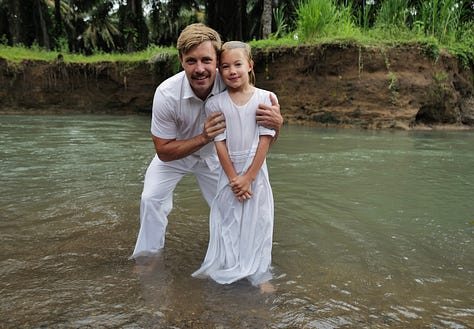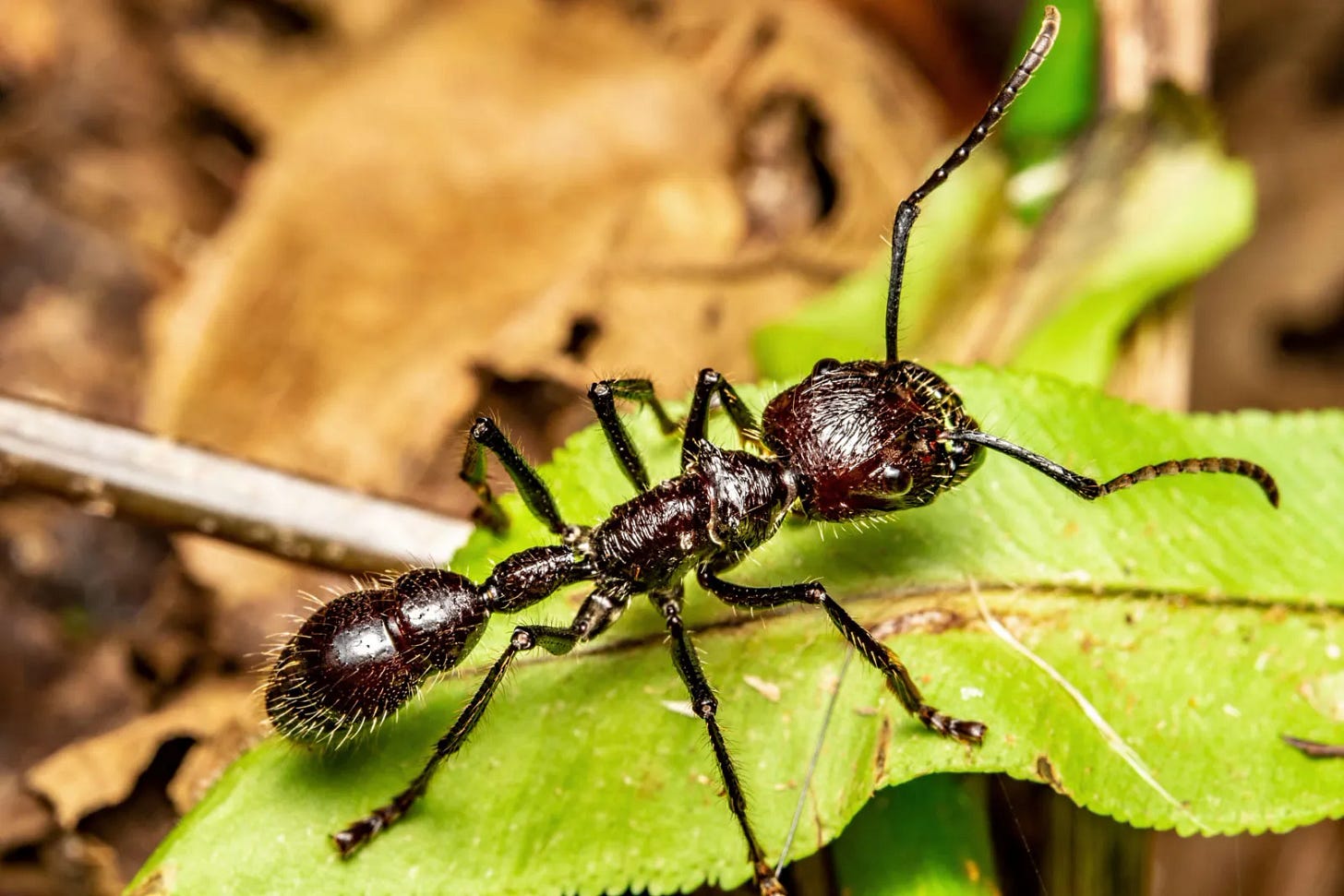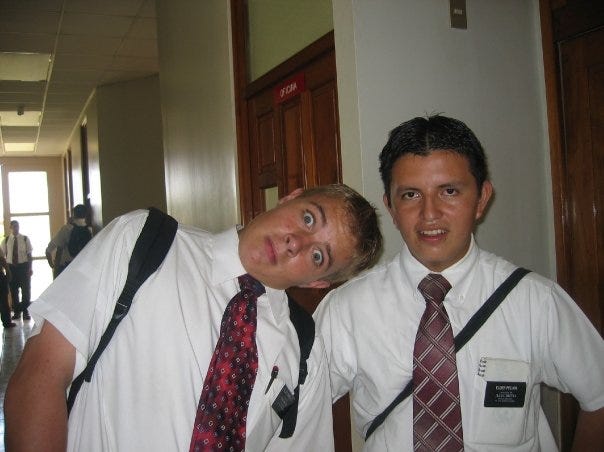Bullet Ants & Baptism
Our daughter Norah is almost nine and until last weekend, had not yet been baptized. This short scene from Nacho Libre sums it up really well:
Courtney and I have struggled with the decision to baptize her for a while and until recently, have had zero clarity on what to do. For those who may need additional context on our current belief status, see this post. Some might argue that it’s her decision to make and not ours. But, as is the case with most eight-year-olds, we still have to point out that her shirt is on backwards from time to time, suggesting that her decision making skills may still be developing.
The real struggle? We’re grappling with a decision that, once upon a time, we never would have thought twice about! Like any ‘covenant born’ LDS couple, we envisioned our sweet little daughter sitting on the front pew at the stake center in a white jump suit next to all the other eight year olds. We imagined the Primary Presidency member giving a talk about the Gift of the Holy Ghost. When I Am Baptized would be playing on the piano as we migrated from chapel to font, young cousins pressing their faces against the glass for a better view. The rest of the family forced to crane their necks toward the giant overhead mirror as their only viewing option. Afterward, we’d change clothes and she’d unwrap a set of scriptures from grandma with her name embossed in gold along the bottom and we’d be on our way to the Celestial! Good and worthy vision, right? But we just couldn’t bring ourselves to do it.
So what changed? Clearly something, because there we are in those pictures down below—dressed in white, happy, smiling, and honestly glad we did it.
As part of our beloved book club (it’s called ‘No Shelf Control), we recently read a popular book called The Anxious Generation. We didn’t expect this book to address our hesitations about Norah’s baptism, but it subtly worked its way into our minds, and lead us to a few ideas we hadn’t fully considered. In one section, the author talks a lot about ritual and tradition and how most rituals aren’t just about the specific religious or cultural beliefs that they may represent on the surface. Instead, they often carry deeper, universal meanings such as the acknowledgment of personal growth, the affirmation of community values, and the reinforcement of social bonds. He emphasizes that for many, participating in these rituals provides a sense of security and identity in an ever-changing world, offering a moment to pause, reflect, and celebrate significant life events. These were all ideas we could get behind when held up against our own daughter’s situation. These were things we wanted for her and, that she communicated she wanted for herself as well. With those thoughts continuing to percolate, we left for Costa Rica.
On our fourth night in the country, we took a nocturnal tour with a local guide named Diego. At one point, we came to a fallen tree that had blocked the trail we were on. As we started to step over it, Diego suddenly shouted for us to stop, frantically telling us to pick up the kids and back away. Once at a safe distance, he brandished a laser pointer and hovered the bright green dot just below several of the biggest ants I’d ever seen, scurrying all over the tree trunk. These weren’t your average ants—they were at least an inch long with massive pincers and extra long antennae, making them look even more menacing. “Bullet Ants,” Diego said in his heavy Latin accent. “We want to avoid those,” he continued in Spanish. He explained that the Bullet Ant gets its name from the enduring pain it causes when it stings. Apparently it is one of the most painful insect stings in existence and feels a lot like getting shot with an actual bullet, causing intense agony that can last more than 24 hours. Ouchie!
Further down the trail, Diego told us about an indigenous tribe in Brazil called the Sateré-Mawé who rely on these ants to carry out a long standing tradition for boys turning 12 years-old. How coincidental, right? With our thoughts already on traditions and rituals, we asked a lot of questions. He told us the ants are temporarily sedated and then carefully woven into the lining of a special set of mittens made from palm leaves. 80 to 120 bullet ants are placed inside each mitten with their stingers facing inward to provide maximum access to the skin of the eventual wearer.
When we got back to wifi, I did some quick YouTubing and learned more about the intensity of this tradition (check it out here). As part of the ritual, the boys wear the gloves for 10 full minutes, enduring hundreds of bites as the ants wake up. Supportive leaders and community members are close by, chanting tribal hymns and offering words of encouragement as the boys endure bite after bite, the pain from which continues to intensify, peaking anywhere from 5 to 30 minutes later! This rite of passage is meant to teach courage, endurance, and respect for nature.
With our thoughts on our takeaways from the book and our lingering decision around Norah’s baptism, it was easy to see the Bullet Ant tradition was another example of how rituals can create deep social bonds and a sense of connection within a community. The Sateré-Mawé tribe might have their own beliefs tied to this intense tradition, but at its core, it’s about fostering belonging and marking an important life transition. We realized that the hesitancy to baptize Norah stemmed mostly from a worry that it was tied too closely to LDS doctrine or membership—things that no longer align with our focus. But this experience helped us realize that we did not want that narrower view stop us from embracing the broader, more meaningful aspects of the tradition, like celebrating an important life transition for our daughter.
As gringos raised here in Utah, our culture, traditions, and rites of passage differ slightly from those of the Sateré-Mawé. At 12 years-old, our youth typically avoid Bullet Ant bites and are tasked instead with passing trays of bread and water. Anyone who’s had to memorize a complicated sacrament passing route or run out of water cups during a large meeting knows that bravery and courage are still required! At eight, our kids get baptized as a symbolic gesture of commitment and a ritualistic “welcome to the community.”
Three days after our Bullet Ant encounter, we headed to the Caribbean side of Costa Rica. Halfway through the four-hour drive, we stopped for gas in a larger city called San Ramon. Since it was Sunday, I checked to see how far we were from the local ward. Surprisingly, the chapel was just a couple blocks down the street. We drove over and ended up chatting with two sister missionaries. I should probably mention that I served my own mission in Nicaragua nearly two decades ago, so being in neighboring Costa Rica always takes me back to my days as Elder Wardrop—another cultural tradition that shaped my life in ways I’m deeply grateful for. I half-mentioned our desire to baptize Norah, and after learning where we were headed, the sisters gave us the contact info for the missionaries in the costal town of Quepos, and told us they’d be happy to help.
After some calls and coordination, the sisters in Quepos helped us find a small white dress for Norah and a pair of white pants for myself. We drove far off the beaten path into a small pueblo to pick up Ricardo, a member of the local bishopric who was available to attend as a witness. I asked him about the best local swimming holes, and without hesitation, he guided our little SUV to the perfect spot. A gently flowing aqua-blue river surrounded by palm tree plantations. The scene looked liked something straight out of a poster you’d checkout at the ward library. As we got out of the car, Max started screaming—he’d stepped in a bunch of small biting ants. He recovered quickly, but our thoughts went right back to tradition, ritual, and celebration. We walked down to the sandy riverbanks, stepped into the water, and took part in one of our own culture’s most significant rituals.
While I can’t quite put my finger on it, there was something undeniably special about that moment we shared while celebrating Norah. Everything was quiet. Everyone felt good. I’ve always believed that love is the only “true” thing in existence, and standing there with Ricardo and my family, in a country we’ve long cherished, I felt that love in full force.



Early in our faith journey about eight years ago, we met a prominent local Buddhist and meditation guide who had also been raised in the church. He shared his journey and the experiences that led him to his current beliefs. One notable moment was when he had the rare opportunity to meet with the Dalai Lama. During their conversation, the Dalai Lama asked where he was from. When our friend said “Utah,” the Dalai Lama lit up and asked, “Are you a Mormon then?” Surprised, our friend explained that he had grown up LDS but had since “moved on” to what he felt was a more enlightened path. The Dalai Lama gently replied, “Moved on from what? Mormonism is a wonderful religion with wonderful people and traditions. Learning a new language does not require one to abandon their mother tongue.”
Standing by that river in Costa Rica, celebrating our sweet eight-year-old daughter, we realized that while our beliefs have and will certainly continue to change and evolve, there can still be a whole lot of beauty in honoring our mother tongue.







